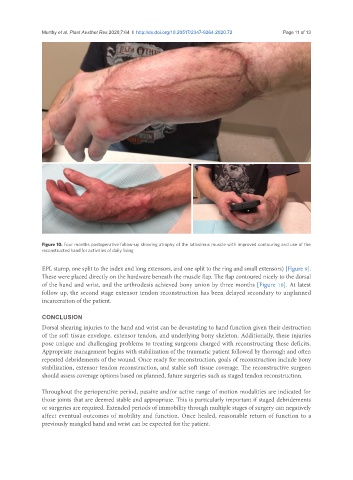Page 761 - Read Online
P. 761
Murthy et al. Plast Aesthet Res 2020;7:64 I http://dx.doi.org/10.20517/2347-9264.2020.72 Page 11 of 13
Figure 10. Four months postoperative follow-up showing atrophy of the latissimus muscle with improved contouring and use of the
reconstructed hand for activities of daily living
EPL stump, one split to the index and long extensors, and one split to the ring and small extensors) [Figure 9].
These were placed directly on the hardware beneath the muscle flap. The flap contoured nicely to the dorsal
of the hand and wrist, and the arthrodesis achieved bony union by three months [Figure 10]. At latest
follow up, the second stage extensor tendon reconstruction has been delayed secondary to unplanned
incarceration of the patient.
CONCLUSION
Dorsal shearing injuries to the hand and wrist can be devastating to hand function given their destruction
of the soft tissue envelope, extensor tendon, and underlying bony skeleton. Additionally, these injuries
pose unique and challenging problems to treating surgeons charged with reconstructing these deficits.
Appropriate management begins with stabilization of the traumatic patient followed by thorough and often
repeated debridements of the wound. Once ready for reconstruction, goals of reconstruction include bony
stabilization, extensor tendon reconstruction, and stable soft tissue coverage. The reconstructive surgeon
should assess coverage options based on planned, future surgeries such as staged tendon reconstruction.
Throughout the perioperative period, passive and/or active range of motion modalities are indicated for
those joints that are deemed stable and appropriate. This is particularly important if staged debridements
or surgeries are required. Extended periods of immobility through multiple stages of surgery can negatively
affect eventual outcomes of mobility and function. Once healed, reasonable return of function to a
previously mangled hand and wrist can be expected for the patient.

